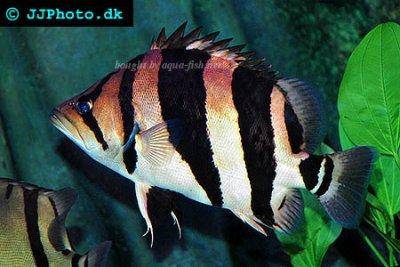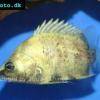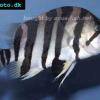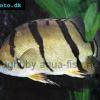Siamese tiger datnoid - Datnioides microlepis
Scientific name: Datnioides microlepis
Common name: Siamese tiger datnoid
Family: Datnioididae
Usual size in fish tanks: 28 - 30 cm (11.02 - 11.81 inch)
014
Recommended pH range: 6.5 - 7.5
Recommended water hardness: 8 - 18°N (142.86 - 321.43ppm)
0°C 32°F30°C 86°F
Recommended temperature range: 24 - 27 °C (75.2 - 80.6°F)
The way how these fish reproduce: Spawning
Where the species comes from: Southeast Asia
Temperament to its own species: peaceful
Temperament toward other fish species: aggressive to smaller
Usual place in the tank: Middle levels
Short description
Datnioides microlepis, commonly called the Siamese tiger datnoid or Indonesian tiger datnoid, is a striking predatory species from Southeast Asia. It is characterized by its bold vertical black stripes on a golden to silvery body. In aquaria it typically grows to 28–30 cm, though wild specimens may exceed 40 cm. Juveniles show bright contrasting bands, which may darken or fade with age. Datnoids are ambush predators that spend much of their time hovering motionless in midwater, making sudden strikes on prey.
Origin
This species is native to Southeast Asia, especially the Mekong and Chao Phraya basins, as well as rivers in Cambodia, Vietnam, Thailand, and western Borneo. It inhabits slow to moderate flowing rivers, flooded forests, and estuarine zones, often in turbid water with submerged roots or structures.
Food and feeding
A strict carnivore that will readily consume smaller tank mates if given the chance. In captivity it adapts to shrimp pellets, chopped earthworms, frozen prawns, bloodworms, krill, and small fish fillets. Juveniles may require live foods initially but should be weaned onto prepared diets for long-term health. Feed in moderate amounts 1–2 times daily to prevent obesity.
Sexing
No reliable external differences are known. Mature females may appear fuller-bodied, but sexing is very difficult without venting or breeding context.
Breeding
Breeding in home aquaria has not been documented. In Indonesia, D. microlepis is commercially bred on farms, though exact techniques are not published. They are presumed substrate or structure spawners with parental care. In captivity, controlled spawning likely requires very large ponds or hormone induction.
Lifespan
With proper care they can live 10–15 years, sometimes longer in large, well-maintained aquaria.
Behavior and compatibility
Although sometimes described as “peaceful” for a predator, Siamese tiger datnoids are opportunistic hunters. They generally tolerate robust, similarly sized tank mates such as large catfish, bichirs, or larger cichlids, but anything small enough to swallow will be eaten. Among themselves, they may quarrel, especially in cramped tanks. Groups require very spacious aquaria to disperse aggression. Provide large rocks, caves, and driftwood for cover.
Tank requirements
- Tank size: at least 500 liters for a single specimen; 750 liters recommended for a group.
- Décor: large driftwood, rock structures, and open midwater zones for cruising. Moderate flow helps simulate riverine conditions.
- Lighting: subdued to moderate; bright light may make them shy.
- Filtration: powerful external or sump filters with high turnover; datnoids are messy predators.
Notes on identification
It is important not to confuse Datnioides microlepis with the closely related Datnioides pulcher, the true Siamese tigerfish. D. pulcher originates from the Mekong basin in Cambodia and Thailand and is critically endangered and legally protected; its capture and trade are banned. As a result, the “tiger datnoids” available in the aquarium trade are almost always D. microlepis, which is still relatively widespread in Indonesia and parts of mainland Southeast Asia. Correct identification helps ensure hobbyists do not contribute to illegal trade of threatened species.
Pictures
Bought by aqua-fish.net from jjphoto.dk.





 New
New  Siamese
Siamese  Mekong
Mekong